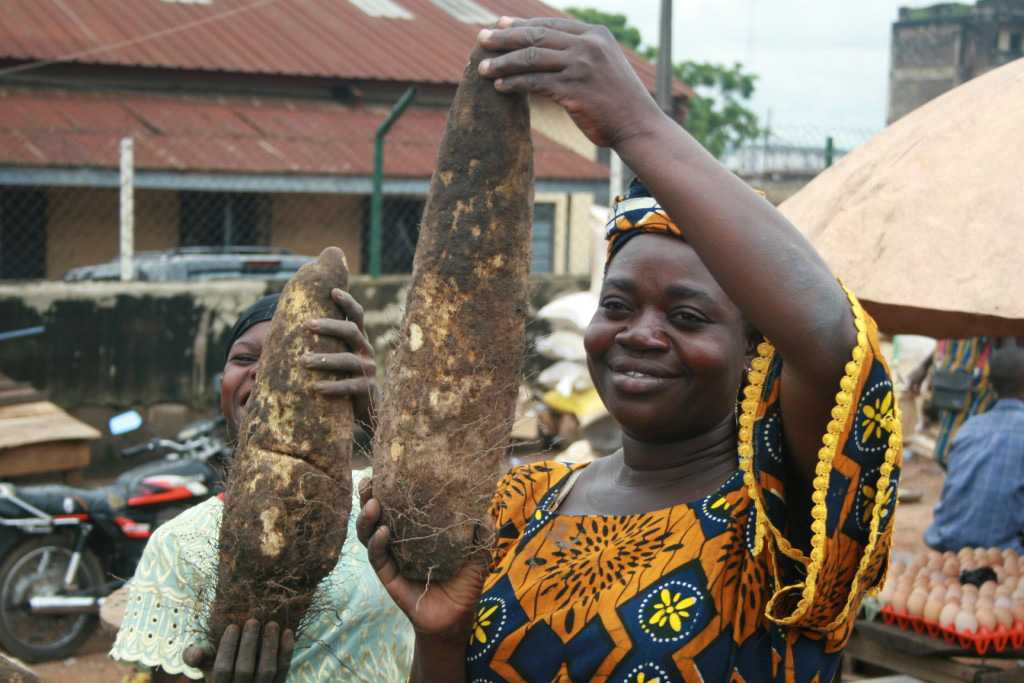West African Yam Festivals Celebrate Harvest, Community and Life Itself
Across the world’s yam belt, the tuber represents far more than just a side dish.
West African Yam Festivals Celebrate Harvest, Community and Life Itself
Across the world’s yam belt, the tuber represents far more than just a side dish.

Women in Benin show off their yams.courtesy of IITA.org.
In Emure Ekiti, a town in Nigeria, hundreds of townspeople troop into the streets to celebrate the season of the yam harvest. Women sing praises and chant prayers, dressed in beautifully printed ankara outfits. A man sounds a large gong, while children carry pieces of yam on their heads, careful not to let them fall. When they arrive at the palace, the king blesses the community and the harvest, and the festivalgoers celebrate by eating of the new yam, whether boiled, pounded, roasted or mashed into a porridge.
These are scenes from the Iluyanwa Yam Festival. Celebrations of culture, community and life, yam festivals occur throughout West Africa. The festivals are essential events; they mark the passing of another season, honor religious offerings and provide a cultural focal point for a whole town to converge around. It’s a community celebration, supported by local organizations or governments, bringing together dozens, hundreds or even thousands of people every year—all to celebrate the humble yam.

Frequently called the “yam belt,” West Africa accounts for 94% of the world’s yam production, with Nigeria alone producing about 50 million tonnes annually, more than two-thirds of the global yam crop. The cultivation of yams began in the region some 11,000 years ago, as a result of a cultural interaction between grain-crop agriculturalists who were being forced southward by the progressive desiccation of the Sahara and gatherers in the forests and savannahs of West Africa, who were eating wild yams but not yet cultivating them.
The yam is considered by most West African ethnic groups to be a symbol of fertility and the sustainability of life, and it often plays versatile cultural roles, used in inaugural, wedding and naming ceremonies. Yam festivals, which mark an important changing of the seasons, bring the community together to celebrate the harvest and give thanks to the gods.
“The festival is held in commemoration of the gods of the land for a good harvest season,” says Tatiana Haina, who creates food and travel vlogs on YouTube and covers the cultural festivals of her native Ghana. One such festival is the Krufie Yam Festival, celebrated by the indigenous people of Bredi, a community near Nkoranza in the Bono East region of the country. “The people believe the gods of the land have been very protective throughout the year and hence use the festival as a way of showing appreciation to the gods for their guidance and protection into a new bumper season,” she says.

Over the past decade, the ceremonies have become a significant contribution to West Africa’s tourism, bringing attention and tourists interested in the cuisine. Traditionally celebrated in the open like most food festivals, yam festivals across regions attract both thousands of locals and visitors from the United States, Canada, Netherlands and further afield. “There is usually a lot of chanting, singing, drumming, dancing and costume displays by the local people,” says Jahman Anikulapo, a Nigerian culture activist and archivist. He believes cultural festivals such as the yam festivals unite the community and stimulate a general feeling of camaraderie.
Yam festivals often encourage and reward agricultural production. For instance, among the Ewe people in Ghana and Togo, different farmers present their yams in a competition to be named “chief farmer” or “Yam King.” And because some ethnic groups, such as the Igbo, believe the productivity of the tuber crop to be influenced by spiritual forces linked with the earth, yam festivals become an avenue to offer thanks to the gods of the land.
In ancient days, the yam was a major crop plant in empire-states and kingdoms such as Ashanti, Dahomey, Nri, Ife and Benin, and before the harvest, festivals were often celebrated to mark a new year. “The festivals are particularly popular in the southeastern part of the country,” says Anikulapo. He recalls his stay in the state of Enugu, where yams were brought to a king’s palace and, after the affair was officiated by a chief priest, instructions were given to plant setts of yams to secure another bountiful harvest in the next year.

But yam festivals are not only celebrated today among the Igbo, Urhobo, Yoruba and Ijaw people of Nigeria. Outside the country, the festivals are prevalent among the Bono and Ashanti people of the Akan ethnic groups in Ghana; the Fon people of the Republic of Benin; the Ewe people in Togo, and the Ashanti and Anyi people of the Akan ethnic groups in Cote d’Ivoire.
As the Fon people of Benin have strong ties with the Yoruba of Nigeria and the Akan people in Cote d’Ivoire with their fellow ethnic group in Ghana, the festivals are celebrated with just as much pomp and procession. Traditionally, the newly harvested yams are not eaten until members of a particular group—usually the chief’s household or the chief priests—have partaken of the new crop. But, unlike other ethnic groups, a special celebration of the new yam is held exclusively by Fon women in certain clans, in which, after the sacrifice of a ram and fowl, the new yams are ritually pounded and, after being offered to deities, eaten by the women and children.
“The festival can be celebrated for a month. It depends on the location and the people involved,” says Haina. Among the Igbos and the Fon people, the festival is usually in late July or August, and it could span days. For the Yoruba people in Ekiti State, Nigeria, the feast is celebrated in August and spans a day or two.

Yam festivals are usually sponsored by the local community. “Support comes mostly from age grade groups [a form of social organization based on age], other social clubs and even some state governments in southeastern Nigeria,” says Anikulapo who, however, stresses the negligence of the government in supporting these cultural celebrations at the federal level. “There is no cultural policy in the country.”
The yam festivals are even being exported to the diaspora, where they are bringing together West Africans in Europe, Asia and the Americas. Organizations such as ICSN (Igbo Cultural and Support Network) of London, Isuikwuato Community of Qatar and Ndi-Igbo Germany of Frankfurt have kept the celebrations alive outside of the continent. The goal is to maintain tradition: If a rite or ritual is performed by the Bono people in Ghana, the same rite will take place for Bono people celebrating in the US. London’s Igbo community members delight in dancing and singing with the same vigor and splendor as their compatriots back in Nigeria. The celebrations might take place in halls, ballrooms or auditoriums, rather than in the open air, but that allows celebrants to issue invitations to select guests.
As the West African diaspora grows, yam festivals will travel to further corners of the globe, and include more and more people. More than just a one-off event, these festivals can open crucial dialogues about the balance of food tourism and food sovereignty, as more folks become acquainted with the yam.
Follow us
This work is licensed under a Creative Commons Attribution-NoDerivatives 4.0 International License.
Want to republish a Modern Farmer story?
We are happy for Modern Farmer stories to be shared, and encourage you to republish our articles for your audience. When doing so, we ask that you follow these guidelines:
Please credit us and our writers
For the author byline, please use “Author Name, Modern Farmer.” At the top of our stories, if on the web, please include this text and link: “This story was originally published by Modern Farmer.”
Please make sure to include a link back to either our home page or the article URL.
At the bottom of the story, please include the following text:
“Modern Farmer is a nonprofit initiative dedicated to raising awareness and catalyzing action at the intersection of food, agriculture, and society. Read more at <link>Modern Farmer</link>.”
Use our widget
We’d like to be able to track our stories, so we ask that if you republish our content, you do so using our widget (located on the left hand side of the article). The HTML code has a built-in tracker that tells us the data and domain where the story was published, as well as view counts.
Check the image requirements
It’s your responsibility to confirm you're licensed to republish images in our articles. Some images, such as those from commercial providers, don't allow their images to be republished without permission or payment. Copyright terms are generally listed in the image caption and attribution. You are welcome to omit our images or substitute with your own. Charts and interactive graphics follow the same rules.
Don’t change too much. Or, ask us first.
Articles must be republished in their entirety. It’s okay to change references to time (“today” to “yesterday”) or location (“Iowa City, IA” to “here”). But please keep everything else the same.
If you feel strongly that a more material edit needs to be made, get in touch with us at [email protected]. We’re happy to discuss it with the original author, but we must have prior approval for changes before publication.
Special cases
Extracts. You may run the first few lines or paragraphs of the article and then say: “Read the full article at Modern Farmer” with a link back to the original article.
Quotes. You may quote authors provided you include a link back to the article URL.
Translations. These require writer approval. To inquire about translation of a Modern Farmer article, contact us at [email protected]
Signed consent / copyright release forms. These are not required, provided you are following these guidelines.
Print. Articles can be republished in print under these same rules, with the exception that you do not need to include the links.
Tag us
When sharing the story on social media, please tag us using the following: - Twitter (@ModFarm) - Facebook (@ModernFarmerMedia) - Instagram (@modfarm)
Use our content respectfully
Modern Farmer is a nonprofit and as such we share our content for free and in good faith in order to reach new audiences. Respectfully,
No selling ads against our stories. It’s okay to put our stories on pages with ads.
Don’t republish our material wholesale, or automatically; you need to select stories to be republished individually.
You have no rights to sell, license, syndicate, or otherwise represent yourself as the authorized owner of our material to any third parties. This means that you cannot actively publish or submit our work for syndication to third party platforms or apps like Apple News or Google News. We understand that publishers cannot fully control when certain third parties automatically summarize or crawl content from publishers’ own sites.
Keep in touch
We want to hear from you if you love Modern Farmer content, have a collaboration idea, or anything else to share. As a nonprofit outlet, we work in service of our community and are always open to comments, feedback, and ideas. Contact us at [email protected].by Mayowa Oyewale, Modern Farmer
April 18, 2023
Modern Farmer Weekly
Solutions Hub
Innovations, ideas and inspiration. Actionable solutions for a resilient food system.
ExploreExplore other topics
Share With Us
We want to hear from Modern Farmer readers who have thoughtful commentary, actionable solutions, or helpful ideas to share.
SubmitNecessary cookies are absolutely essential for the website to function properly. This category only includes cookies that ensures basic functionalities and security features of the website. These cookies do not store any personal information.
Any cookies that may not be particularly necessary for the website to function and are used specifically to collect user personal data via analytics, ads, other embedded contents are termed as non-necessary cookies.
Yes!